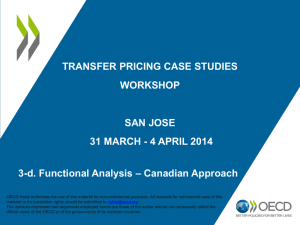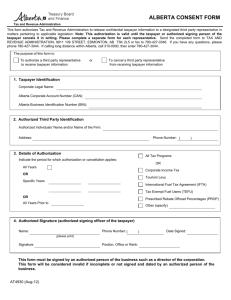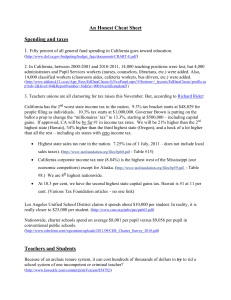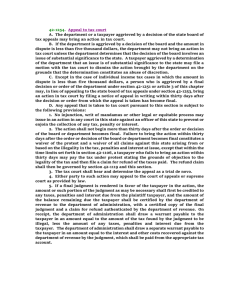tax law bulletin - Borden Ladner Gervais LLP
advertisement
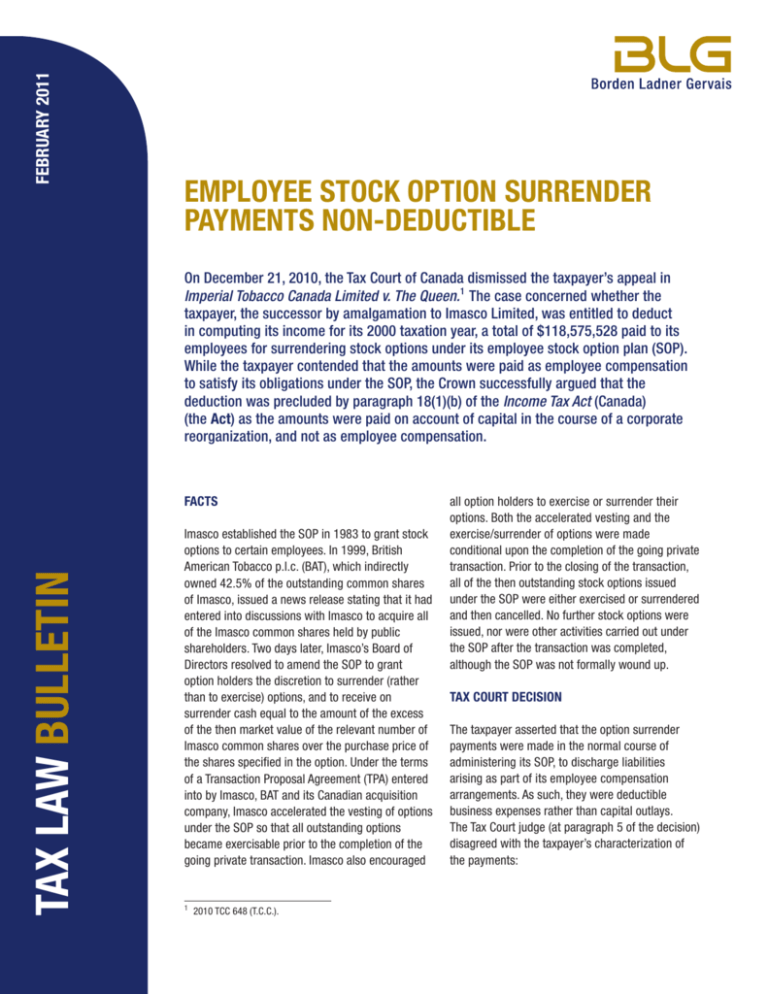
FEBRUARY 2011 EMPLOYEE STOCK OPTION SURRENDER PAYMENTS NON-DEDUCTIBLE On December 21, 2010, the Tax Court of Canada dismissed the taxpayer’s appeal in Imperial Tobacco Canada Limited v. The Queen.1 The case concerned whether the taxpayer, the successor by amalgamation to Imasco Limited, was entitled to deduct in computing its income for its 2000 taxation year, a total of $118,575,528 paid to its employees for surrendering stock options under its employee stock option plan (SOP). While the taxpayer contended that the amounts were paid as employee compensation to satisfy its obligations under the SOP, the Crown successfully argued that the deduction was precluded by paragraph 18(1)(b) of the Income Tax Act (Canada) (the Act) as the amounts were paid on account of capital in the course of a corporate reorganization, and not as employee compensation. TAX LAW BULLETIN FACTS Imasco established the SOP in 1983 to grant stock options to certain employees. In 1999, British American Tobacco p.l.c. (BAT), which indirectly owned 42.5% of the outstanding common shares of Imasco, issued a news release stating that it had entered into discussions with Imasco to acquire all of the Imasco common shares held by public shareholders. Two days later, Imasco’s Board of Directors resolved to amend the SOP to grant option holders the discretion to surrender (rather than to exercise) options, and to receive on surrender cash equal to the amount of the excess of the then market value of the relevant number of Imasco common shares over the purchase price of the shares specified in the option. Under the terms of a Transaction Proposal Agreement (TPA) entered into by Imasco, BAT and its Canadian acquisition company, Imasco accelerated the vesting of options under the SOP so that all outstanding options became exercisable prior to the completion of the going private transaction. Imasco also encouraged 1 2010 TCC 648 (T.C.C.). all option holders to exercise or surrender their options. Both the accelerated vesting and the exercise/surrender of options were made conditional upon the completion of the going private transaction. Prior to the closing of the transaction, all of the then outstanding stock options issued under the SOP were either exercised or surrendered and then cancelled. No further stock options were issued, nor were other activities carried out under the SOP after the transaction was completed, although the SOP was not formally wound up. TAX COURT DECISION The taxpayer asserted that the option surrender payments were made in the normal course of administering its SOP, to discharge liabilities arising as part of its employee compensation arrangements. As such, they were deductible business expenses rather than capital outlays. The Tax Court judge (at paragraph 5 of the decision) disagreed with the taxpayer’s characterization of the payments: TAX LAW BULLETIN | FEBRUARY 2011 2 To take this view of the matter one would have to consider the decision to accelerate the vesting of unvested options, the decision to amend the SOP to permit the holders of options the discretion to surrender them for cash, and the cessation of the granting of options all in isolation from the going private transaction whereby BAT Canada sought to acquire all the outstanding shares of Imasco. Doing so would be contrary to the test in B.P. Australia Ltd. v. Commissioner of Taxation 2, as approved by the Supreme Court of Canada in Johns-Manville v. The Queen.3 Under that test, the Tax Court judge had to consider all of the “guiding features” of the taxpayer’s case in determining from a practical and business point of view what the taxpayer’s payments under the SOP were intended to accomplish. In analyzing the taxpayer’s circumstances, the Tax Court judge considered a prior case on point relied on by the Crown. In Kaiser Petroleum Ltd. v. The Queen 4, the Federal Court of Appeal held that the taxpayer’s payment to extinguish an employee share option plan was a payment on account of capital. Although employee compensation was the reason for the initial implementation of the stock option plan, as well as a purpose of terminating the plan, under the B.P. Australia Ltd. test the “guiding element” of the payment was to reshape the capital structure of the taxpayer. To support its position, the taxpayer relied upon the judgment in Imperial Tobacco Canada Limited (Successor by Amalgamation to Shoppers Drug Mart Limited) v. The Queen 5, in which the Tax Court distinguished the Kaiser case. While that case also involved the Imasco going private transaction, Shoppers Drug Mart (SDM) paid the amounts in question to its parent, Imasco, to reimburse Imasco for paying SDM’s employees for surrendering their options under the SOP. While Imasco’s payments to SDM’s employees were made in the context of reorganizing Imasco’s capital structure, the Tax 2 [1966] AC 224 (J.C.P.C.). [1985] 2 S.C.R. 46 (S.C.C.). 4 90 DTC 6603 (F.C.A.). 5 2008 DTC 2043 (T.C.C.). 6 Supra, footnote 1 at paragraph 11. 3 Court held that SDM’s payments to Imasco were deductible since SDM made them to reimburse Imasco, not to reshape its capital structure. The Tax Court judge easily dismissed the relevance of that case to the present facts since the taxpayer’s capital structure was clearly restructured. The Tax Court also disagreed with the taxpayer’s assertions that Kaiser was distinguishable from the facts before it. The taxpayer argued that it had only agreed to encourage the surrender or exercise of stock options and, thus, its payments were made to satisfy obligations to its employees under the SOP, not to make the takeover transaction possible as in Kaiser. The taxpayer also noted that, in contrast to Kaiser, the TPA did not require the taxpayer to extinguish the SOP, and the SOP was not formally terminated; the taxpayer’s payments were not related to employee retention, and its payment obligation arose under the SOP and not the TPA; the taxpayer’s employees had the right to surrender vested options under the SOP whether or not the going private transaction was completed, and could choose to exercise, surrender or retain their options rather than being required to surrender their options for cash or have them terminated; and the SOP allowed both early vesting and cash surrender of options since 1995. The Tax Court judge concluded that these were “all distinctions without a difference”.6 While fairness to Imasco’s employees in the context of the impending going private transaction might have necessitated the accelerated vesting of unvested options, it did not require Imasco to make the option surrender payments. Considering all of the relevant facts surrounding the option surrender payments, the Court concluded: It is clear from the [TPA] at section 5.8 that the mutual intention of BAT and Imasco was that, so far as it was feasible to do so, all outstanding options to purchase shares would be eliminated before the completion of the [going private] transaction. If 3 compensation was an element of the decision to make the payments then nevertheless, as in the Kaiser Petroleum case, the reshaping of [Imasco’s] capital structure “dominate[d] the whole set of circumstances…and constitute[d] the guiding element…”. The real question in each case is “what was the expenditure calculated to effect from a practical and business point of view?” Given the timing of the amendment to the SOP on June 7, 1999, coincident with the press release the same day by which BAT announced that discussions were taking place, and followed on August 2, 1999 by the signing of the [TPA] in which section 5.8 set out the parameters for the elimination, so far as possible, of outstanding options, there can be no serious doubt as to what the expenditure was calculated to effect. It was calculated to give BAT some assurance that on completion of the going private transaction there would be few or no outstanding options remaining in the hands of Imasco employees. If all that Imasco intended was to settle up with its employees, as counsel contends, then it need only have accelerated the vesting of unvested options. Employees could then have exercised them at will.7 Finally, the judge dealt briefly with the taxpayer’s reliance on prior Tax Court decisions in which payments were held to be deductible: Boulangerie St. Augustin v. The Queen 8, International Colin Energy Corp. v. The Queen 9, and BJ Services Company Canada v. The Queen.10 In the Court’s view, since the facts of those cases were significantly different than the present facts, it was bound by the Kaiser decision to dismiss the taxpayer’s appeal. Accordingly, the Court upheld the Minister’s assessment denying the taxpayer’s deduction of the option surrender payments. COMMENT The Tax Court’s decision may do little to clarify the circumstances in which taxpayers engaged in transactions are able to deduct stock option surrender payments as current expenses. It is hoped that the Federal Court of Appeal will provide more guidance on this issue when it considers the taxpayer’s appeal of the Tax Court decision. The International Colin Energy and BJ Services cases may suggest an alternative argument for the deductibility of the stock option surrender payments over a five-year period under subparagraph 20(1)(e)(i) of the Act, on the basis that the payments were made “in the course of… [a] sale of…shares of the capital stock of the taxpayer”. In particular, the Tax Court’s obiter comments in International Colin Energy provide a compelling argument that the words “issuance or sale” in subparagraph 20(1)(e)(i) should be interpreted to include not only a sale by a taxpayer of its own shares from treasury but also a sale of a taxpayer’s shares by the taxpayer’s shareholders.11 7 Supra, footnote 1 at paragraphs 11 and 12. 95 DTC 164 (T.C.C.), aff’d 97 DTC 5012 (F.C.A.). 9 2002 DTC 2185 (T.C.C.). 10 2004 DTC 2032 (T.C.C.). 11 Supra, footnote 9, at paragraphs 58-59: “The word ‘issuance’ implies an issuance by the corporation of its own treasury stock. That is not of course what happened here. Here the sale was not by the corporation but by its shareholders. It may well be that even if the payment here is caught by paragraphs 18(1)(a) and (b) it falls broadly within the purpose of paragraph 20(1)(e). The question is however whether ‘in the course of the sale… of the shares of the capital stock of the taxpayer…’ is to be restricted to a sale by the corporation of its own shares. 8 There are respectable arguments on either side. It is arguable that ‘sale’ by its juxtaposition with ‘issuance’ means a sale by the company of its own shares and not a sale by shareholders of their shares. It is equally arguable that ‘issuance’ by itself is quite broad enough to cover a sale by a company of its own shares and that there was no need to add the word sale if all that was meant was a sale by the company. Therefore ‘sale’ must imply something else and the only thing it can refer to is a sale by the shareholders in the course of a corporate transaction of the type involved here where the interests of the corporation are affected. I find the argument attractive not only because it makes sense commercially but because the more restrictive interpretation requires reading into the statute words that are not there. In light, however, of my conclusion on the principal argument advanced in the case I express no concluded view on the point.” AUTHORS Pamela L. Cross Stephanie Wong Ottawa Toronto 613.787.3559 416.367.6198 pcross@blg.comswong@blg.com TAX LAW GROUP National Leader Douglas J. Powrie Vancouver604.640.4097 dpowrie@blg.com Regional Leader Lindsay J. Holmes, Q.C. Calgary 403.232.9605 lholmes@blg.com Charles P. Marquette Montréal514.954.3121cmarquette@blg.com Pamela L. Cross Ottawa 613.787.3559pcross@blg.com Stephen J. Fyfe Toronto 416.367.6650sfyfe@blg.com Douglas J. Powrie Vancouver604.640.4097 dpowrie@blg.com BORDEN LADNER GERVAIS LAWYERS | PATENT & TRADE-MARK AGENTS Calgary Centennial Place, East Tower 1900, 520 – 3rd Ave S W Calgary, AB, Canada T2P 0R3 T 403.232.9500 F 403.266.1395 blg.com Toronto Scotia Plaza, 40 King St W Toronto, ON, Canada M5H 3Y4 T 416.367.6000 F 416.367.6749 blg.com Montréal 1000, De La Gauchetière St W Suite 900 Montréal, QC, Canada H3B 5H4 Tél. 514.879.1212 Téléc. 514.954.1905 blg.com Vancouver 1200 Waterfront Centre 200 Burrard St, P.O. Box 48600 Vancouver, BC, Canada V7X 1T2 T 604.687.5744 F 604.687.1415 blg.com Ottawa World Exchange Plaza 100 Queen St, Suite 1100 Ottawa, ON, Canada K1P 1J9 T 613.237.5160 F 613.230.8842 (Legal) F 613.787.3558 (IP) ipinfo@blg.com (IP) blg.com Waterloo Region Waterloo City Centre 100 Regina St S, Suite 220 Waterloo, ON, Canada N2J 4P9 T 519.579.5600 F 519.579.2725 F 519.741.9149 (IP) blg.com This bulletin is prepared as a service for our clients and other persons dealing with tax law issues. It is not intended to be a complete statement of the law or an opinion on any subject. Although we endeavour to ensure its accuracy, no one should act upon it without a thorough examination of the law after the facts of a specific situation are considered. No part of this publication may be reproduced without prior written permission of Borden Ladner Gervais LLP (BLG). This bulletin has been sent to you courtesy of BLG. We respect your privacy, and wish to point out that our privacy policy relative to bulletins may be found at http://www.blg.com/home/website-electronic-privacy. If you have received this bulletin in error, or if you do not wish to receive further bulletins, you may ask to have your contact information removed from our mailing lists by phoning 1-877-BLG-LAW1 or by emailing unsubscribe@blg.com. © 2011 Borden Ladner Gervais LLP Borden Ladner Gervais LLP is an Ontario Limited Liability Partnership.


